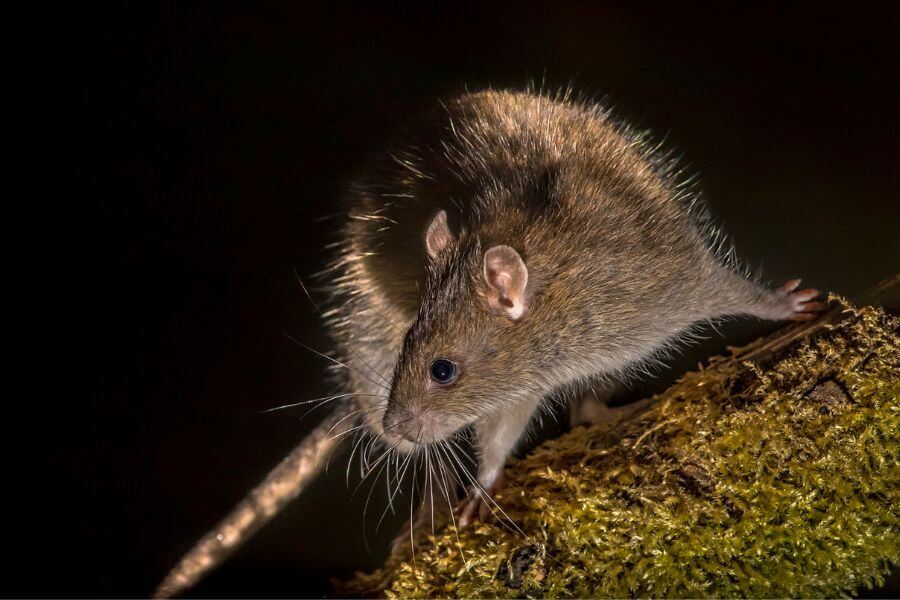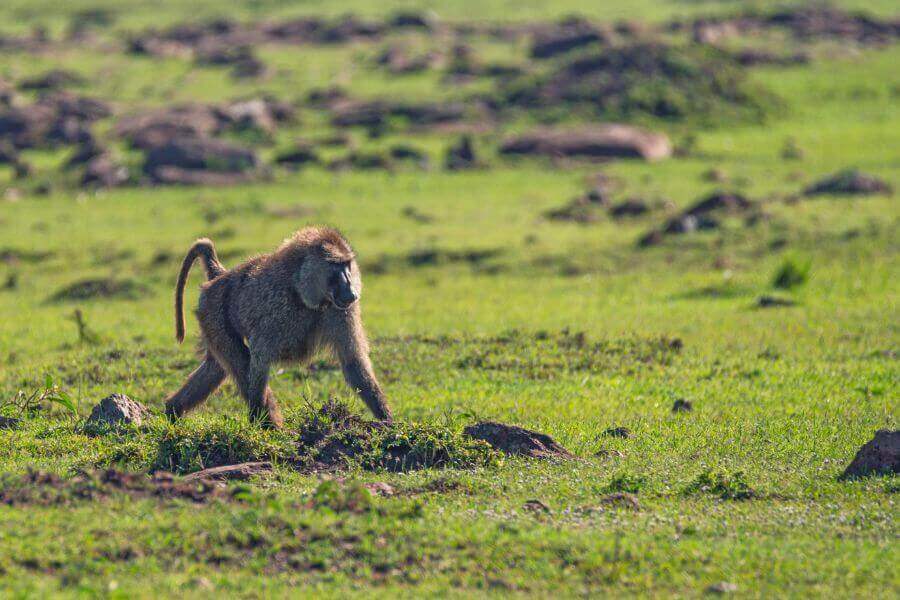Omnivores are animals that eat both plants and animals. Examples of omnivore animals include bears, brown rats, snapping turtles, monkeys, raccoons, and groundhogs.
All animals are part of the larger food chain. They generally have one of three diets: carnivore, herbivore, and omnivore.
Carnivorous animals solely eat meat, while herbivores are dependent on plants for their nutrition.
The omnivore diet is a mix of both. These animals hunt for food but also eat fruits, vegetables, and other plant-based foods. Humans are examples of omnivores.
This article lists the top 19 omnivore animals found in the world.
1. Black Bears

Black bears are medium-sized bears that are native to North America. They are also called American black bears and are the smallest bear species on the continent.
These bears are omnivores and eat meat and vegetation as they eat fruits, grasses, nuts, honeycombs, insects, and fish.
They hibernate in the winter months of October and November[1]. Before entering their dens for hibernating, black bears put up a lot of weight and store the energy as fat to help them pass through the stage.All bears are omnivores, except for the Polar bear and Panda bear, which are carnivores and herbivores respectively.
2. Bearded Dragons

Pogonas (or bearded dragons) are reptiles found in Australia. They live in deserts, grasslands, and shrublands. Their name comes from the underside of their throats, which grows and becomes black when they feel threatened.
Bearded dragons feed on crickets, vegetables, termites, small lizards, and earthworms, making them omnivorous animals.
3. Brown Rats

Rats are found everywhere in the world. They are scavengers and are often found living near human settlements, where they are considered pests.
Brown rats are one of the most common types of rats found in the world. They reach up to 11 inches long, excluding the tail.
Brown rats eat whatever they can find:
- Seeds
- Fruits
- Vegetables
- Nuts
- Caterpillars
- Beetles
- Crickets
- Wood
They are found on every continent of the earth except Antarctica.
4. Chipmunks

Chipmunks are small rodents primarily found in North America. They have striped fur and bushy tails.
They are omnivores and eat meat and plants, such as the following:
- Eggs
- Insects
- Frogs
- Worms
- Grains
- Vegetables
- Fruits
Chipmunks are extremely territorial and do not like to share their food sources with other chipmunks.
5. Snapping Turtles

Snapping turtles are a large species of freshwater turtles native to the North American continent. They have powerful jaws that resemble an eagle’s beak and are known for their strong bite force.[2]
This is a long-lived turtle species, as they reach up to a hundred years
Snapping turtles have a varied diet. They usually eat small fish, clams, frogs, and crayfish. They also eat leeches and aquatic plants.
6. Squirrels

Squirrels are small furry rodents found everywhere in the world. There are many types of squirrels, all of which are omnivores:
- Eastern grey squirrel
- Western grey squirrel
- Arizona grey squirrel
- American red squirrel
- Southern flying squirrel
- Douglas squirrel
- Eastern fox squirrels
Their diets often include a mix of nuts and insects, including acorns, hickory nuts, walnuts, and crickets.
7. Grizzly Bears

One of the largest bear species in the world, the grizzly bear, is a subspecies of the brown bear. They are native to the North American continent. They are omnivorous animals and eat both meat and vegetation.
Grizzly bears commonly hunt ungulates (moose, deer, and elk) with the occasional catch of beavers and fish. They also eat vegetables and fruits, especially berries.
8. Olive Baboons

Baboons are medium-sized primates native to Africa. The olive baboon is one of the most common baboon species in the world. They get their name from the shade of their coat, which is greyish-green in color.
Compared to other primates, baboons spend a lot of time on the ground than on trees. Insects are their primary source of nutrition, but they also eat figs and other fruits, especially in the dry season.
9. Opossums

Opossums are marsupials native to North and South America. They are usually considered pests as they carry diseases and lurk around houses at night.
Opossums are omnivores and eat larvae, mice, eggs, and other insects. They also eat the hatchlings of other animals and can also eat dead flesh.
They have a lifespan of around one to two years and have an average body length of 24 to 33 inches.
10. Ostriches

The largest bird species in the world, the ostrich, is known for its powerful legs and tall structure. They are flightless birds native to Africa and are also omnivores.
Ostriches mainly feed on plants, such as:
- Seeds
- Fruits
- Tubers
- Flowers
- Leaves
- Grasses
- Acacia gum
- Desert salt bush
Ostrich babies are fed small insects such as worms to provide them with the protein needed for their development. Adult ostriches also eat spiders, scorpions, lizards, gophers, and grasshoppers.
11. Owl Monkeys

Monkeys are small primates that live in trees. They are omnivores, with a major portion of their nutrition coming from fruits.
Owl monkeys are one of the species of nocturnal new world monkeys native to the South American continent. As omnivores, they eat flowers, fruits, nectar, spiders, and other small insects.
Owl monkeys live high up in the trees, where they build their nests out of tree branches.
12. Pigs

Pigs are one of the most common domestic animals found in the world. But in the wild, they are both foragers and hunters. They eat insects such as crickets and termites, as well as fruits, grasses, and seeds.
Domesticated pigs are mostly fed plant-based foods, such as cereals and grains. These provide essential fibers that strengthen their digestive system.
13. Red Foxes

Foxes are medium-sized mammals that are primarily omnivores. They have triangular upright ears, pointed snouts, long tails, and flattened skulls.
Red foxes are the most widely spread fox species in the world. They are found in Asia, North America, and Europe.
As opportunistic feeders, red foxes hunt rabbits, small rodents, birds, snakes, fishes, and insects.
Apart from meat, foxes also like to eat blueberries, raspberries, and grasses. They also feed on carrion (dead animals) that they scavenge from wolves, bears, and other predators.
14. Seagulls

Seagulls are medium-sized seabirds with grey and white feathers. They have long bills and webbed feet. Their diet mostly consists of mollusks, crustaceans, eggs, grasses, seeds, grains, and small fish.
Seagulls are often found near coastal areas where they hunt for food. They also eat human food when they come across some.
15. Raccoons

Raccoons are small mammals native to North America. They are extremely intelligent and are often found residing near human settlements.
Raccoons are foragers and eat whatever they can find. They’ve also learned to scavenge on human food waste, on top of their natural foraging.
They usually eat berries, eggs, and small rodents. Some raccoons even eat small birds that they can get their hands on.
16. Warthogs

Warthogs are large wild pigs native to Africa. They live in open habitats and have fur-coated bodies. Their tusks reach lengths of around 10 to 25 inches, depending on the sex and age.
Warthogs eat grass, snakes, insects, fruits, vegetables, mongoose, and shrews. They are powerful diggers, using their feet and snouts to dig deep into the ground. This allows them to search for small insects underground.
Warthogs live in groups called sounders.[3] They are not territorial but do get aggressive during the mating season.
17. Groundhogs

Groundhogs, also known as woodchucks, are medium-sized rodents native to the North American continent. They live on land and belong to a group of squirrels called marmots.
Groundhogs mostly feed on plant-based foods and can eat up to a pound of food per day. They supplement their diet with protein from insects.
Some of the foods they eat include:
- Fruits
- Vegetables
- Grasses
- Seeds
- Eggs
- Insects
Groundhogs are exceptional diggers and build large burrows for their nests. These nests have several compartments, including a bathroom area.
Their great climbing abilities also help them escape predators that enter their burrows, as groundhogs build multiple exit points in each burrow.
18. Dogs

Dogs are some of the most common pets found in the world. They are domesticated companions and working dogs.
All dogs are descendants of wolves which is why they belong in a pack. The pack of domesticated dogs is their owner and family.
Dogs are often considered carnivores, but that is not the case. They are omnivores and can eat both vegetables and meat:
- Bell peppers
- Brussel sprouts
- Fish
- Beef
- Chicken
- Bones
- Cous Cous
- Bok choy
19. American Robins

Robins are small birds found in the United States and Europe. They eat small insects, fruits, berries, spiders, and sometimes small amphibians.
The American robin is one of the most abundant birds found in the United States. They have grey-brown feathers and red bellies. They are diurnal birds and actively search for food during the day.
The average weight of an American robin is around 1 to 1.5 oz.
Conclusion
Omnivores are animals that eat both plants and animals. Examples include bears, rodents, pigs, foxes, and primates.
These animals commonly eat fruits, seeds, fish, insects, and small prey animals.
FAQs
What Is an Omnivore Animal?
Omnivores are animals that can eat meat and plants. They also have teeth that are adapted to eating all kinds of food, such as canines for meat and molars for chewing other foods.
What Animals Are Omnivores?
Examples of omnivores include dogs, raccoons, many rodents, bears, pigs, hedgehogs, and chimpanzees.
Are Humans Omnivores or Carnivores?
Humans are omnivores. We can eat both meat and plants.
Do Omnivores Eat Dead Matter?
Some omnivore animals hunt for their food, while others are scavengers. These animals search for food and often eat decaying or dead food. Bears, foxes, and rodents are some examples of omnivores who eat dead matter.




